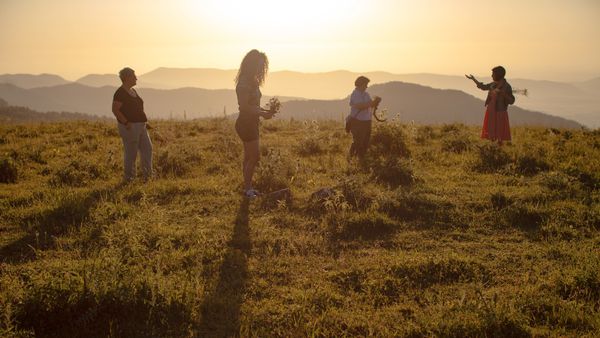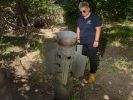Eye For Film >> Movies >> There Was, There Was Not (2024) Film Review
There Was, There Was Not
Reviewed by: Pavla Banjac

Do you remember where you were a year ago? Maybe you skipped your Geography lesson? Maybe you switched off the TV right before the reporter was about to mention Azerbaijan's attack on Artsakh? Maybe they never did? A year ago, this documentary’s four heroines Siranush, Svetlana, Gayane and Sosé were in Artsakh – a country that ceased to exist.
Structured around the simple fact that "In Armenia, stories do not begin with once upon a time, but rather there was, there wasn’t", Emily Mkrtichian, the director of the film and a refugee herself, tells a story about her vanished homeland. Just as the simple negation of the verb to be marks an absolute end in a blink, Artsakh was forced to give up all of its territory to Azerbaijan in less than 24 hours. This, however, is not obvious from the aesthetic and tranquil tone of the beginning as we follow the director while she makes coffee. The symbolic presence of a potential danger is read only once she removes the cezve coffee pot off the stove, saving it from boiling over.

In the same way as Mkrtichian, we meet the four other women in the midst of their lives. They seem content, although the state of their mold-covered homes and their everyday routines reveals extreme poverty and a male-dominanted society. Such a society in which "the women’s rights are cooking and laundry" doesn’t stop Siranush from running for the local elections, nor Gayane from opening up a Women’s Centre. It does not stop Svetlana from being the only female deminer, nor Sosé from being a world champion of a predominantly male sport – judo. Refusing to give any more screen time and attention to men, the rare occasions in which we do see them, they almost never face the camera. This does not go for the lively females of Artsakh’s capital who constantly break the fourth wall. So do the four women, making Mkrtichian their much needed friend, rather than the distant authorial figure of the director. That results in a meta structure which doesn’t serve the technical purpose of art any more, but rather an emotional one, as we witness the director step out to hold the women who trustfully fall apart in front of her camera. Their tight bond becomes crucial once the documentary turns upside down with the first bombs which fall on Artsakh.
The other half of the documentary offers journal-like footage of the terror that people whose country is about to be forever deleted from the map's face. The rough cut between the bombing footage of the civilian buildings next door to the birds chirping across the empty green fields creates almost a fabricated peaceful surrounding for those who have forgotten what peace means. While the physical violence of the war stays in the background with the constant noise of war sirens and bombs, the psychological one is impossible to hide. As Svetlana, whose job was to demine Artsakh from the previous war, starts demining it from the current one, Sosé, who would have given her life for an Olympic Gold, now risks it on the battle front. And for what?
A here-and-there sound of the Russian language all of the people speak reminds us of the chillingly powerful influence that the Soviet Union still has. A protest in front of the European Union building reminds us of why the EU was created in the first place. For what, then? As Siranush stands in front of a world map heartbroken, wondering, "How could we imagine it would change so much", an older lady reminds her, in Russian, that, "The land is temporary, but people are not".
Uninventive in conventional film language, but brave enough to create a new one, There Was, There Wasn’t acts as an artifact of a land forcefully wiped-out from the world’s history. What starts off as a piece of art and a personal recollection turns out to be a collective historical document due to the uncertainty of our frightening fragile reality.
Reviewed on: 12 Nov 2024















